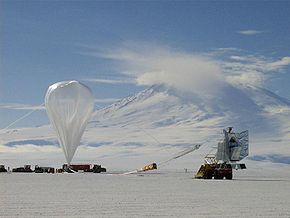Andrew E. Long
Andrew E. Lange (born July 23, 1957 in Urbana (Illinois) , † January 22, 2010 ) was an astrophysicist and Goldberger Professor of Physics at the California Institute of Technology in Pasadena (California) . Lange joined Caltech in 1993 and was most recently Chairman of the Department of Physics , Mathematics and Astronomy . The president of Caltech Jean-Lou Chameau called Lange a truly great physicist and astronomer who made groundbreaking discoveries in observational cosmology ("a truly great physicist and astronomer who had made seminal discoveries in observational cosmology").
education
Lange received a BA in Physics from Princeton University in 1980 and a Ph.D. in physics at the University of California, Berkeley in 1987. He came 1993/94 to Caltech as a visiting professor in 1994 and was a professor . In 2001 he was appointed Goldberger Professor and in 2006 senior research scientist at the Jet Propulsion Laboratory .
Observations of the cosmic background radiation
Long research interests focused on background radiation (CMB) and the instruments to explore it. He developed a new generation of radio receivers for background radiation.
In 1987, a Japanese-American team led by Lange, Paul Linford Richards of UC Berkeley and Toshio Matsumoto of Nagoya University published the claim that the spectrum of background radiation did not match that of a blackbody . Using rocket experiments, they found deviations of 0.5 to 0.7 mm in wavelength. The results challenged the Big Bang theory and supported the rival steady state theory . However, in another publication in 1992, the results of the more precise spectrum measurements of the satellites FIRAS and COBE determined a perfect curve for black bodies with a temperature of 2.73 Kelvin, and thus the old publication was withdrawn.
Lange later was Principal Investigator of the BOOMERanG balloon experiment, which in 1998 confirmed the geometrical flatness of the universe with high precession and thus also the inflationary universe . Most recently, he headed the US delegation for cooperation with the European Planck space telescope , which started in May 2009 to investigate background radiation and gravitational waves .
Prizes and awards
In 2003 Lange and Dr. Saul Perlmutter of the Lawrence Berkeley National Laboratory in Berkeley jointly named “California Scientists of the Year” by the California ScienCenter. Lange became a Fellow of the American Physical Society in 2001 , was a member of the American Academy of Arts and Sciences, and was elected to the National Academy of Sciences for Physics in 2004. In 2006 he shared the Balzan Prize in Observational Astronomy and Astrophysics with Paolo de Bernardis from Italy . In 2009 he received the Dan David Prize (in Astrophysics) for his contributions to understanding the Big Bang .
death
Andrew Lange went to a hotel on January 21, 2010 and was found dead the next day. According to statements made by Detective Lt. John Dewar of the Pasadena Police Department Lange committed suicide .
swell
- ^ A b Janette Williams: Andrew Lange, noted universe researcher at Caltech, dies . ( Memento of the original from May 2, 2010 in the Internet Archive ) Info: The archive link was inserted automatically and has not yet been checked. Please check the original and archive link according to the instructions and then remove this notice. In: Pasadena Star News . January 25, 2010
- ^ Jean-Lou Chameau, in a letter to the Caltech Community, Jan 22, 2010.
- ↑ Caltech Press release, January 23, 2010.
- ^ Balloon Sounds out of the Early Universe. In: Science News . Volume 157, No. 18, p. 276, April 28, 2000.
- ^ Dennis Overbye: Andrew Lange, Scholar of the Cosmos, Dies at 52 . In: New York Times. January 27, 2010
- ↑ Andrew Lange, Ph.D. and Saul Perlmutter, Ph.D. 2003 California Scientists of the Year ( Memento from May 3, 2012 in the Internet Archive )
- ↑ Andrew E. Lange dies at 52; Caltech physicist. In: Los Angeles Times , Associated Press story. Retrieved February 3, 2010.
Web links
- 2009 Dan David Prize Laureate
- Andrew Lange - Daily Telegraph obituary
| personal data | |
|---|---|
| SURNAME | Lange, Andrew E. |
| BRIEF DESCRIPTION | American astrophysicist |
| DATE OF BIRTH | July 23, 1957 |
| PLACE OF BIRTH | Urbana (Illinois) |
| DATE OF DEATH | January 22, 2010 |
